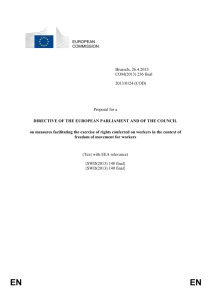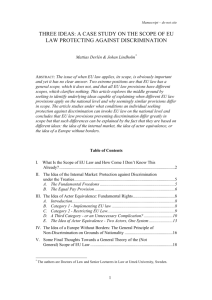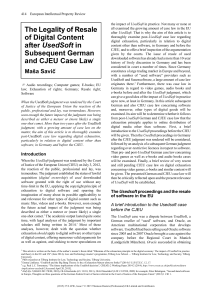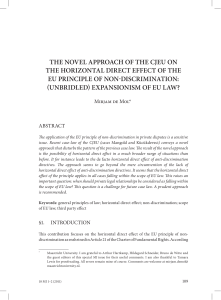Equal pay for work of equal value - era
advertisement
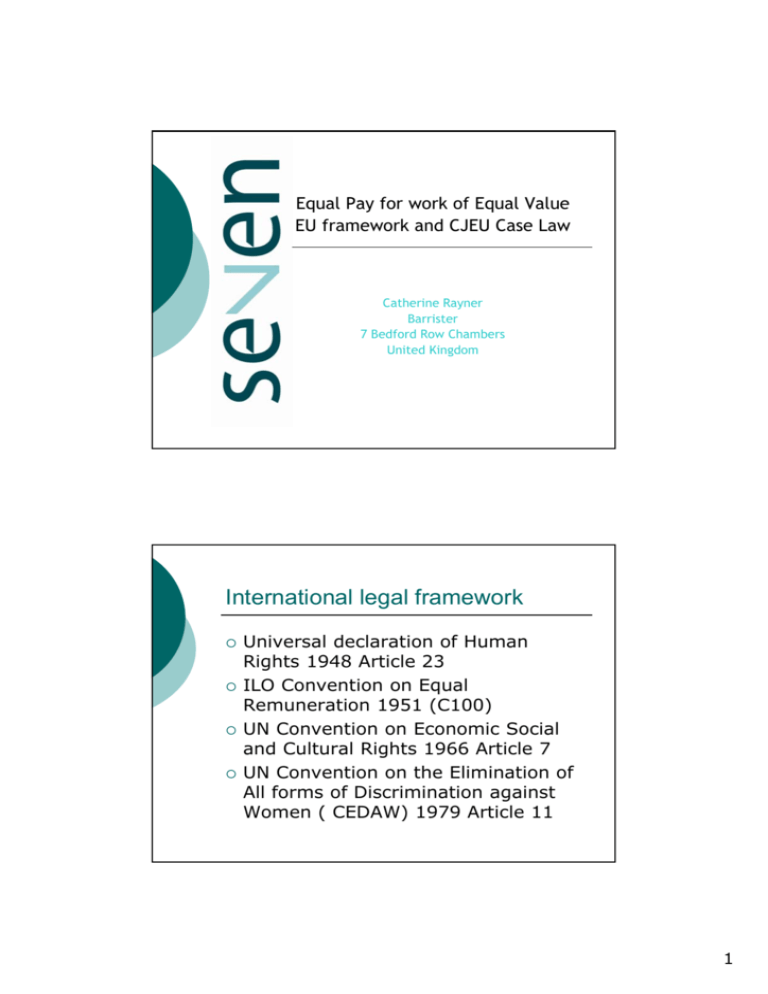
Equal Pay for work of Equal Value EU framework and CJEU Case Law Catherine Rayner Barrister 7 Bedford Row Chambers United Kingdom International legal framework Universal declaration of Human Rights 1948 Article 23 ILO Convention on Equal Remuneration 1951 (C100) UN Convention on Economic Social and Cultural Rights 1966 Article 7 UN Convention on the Elimination of All forms of Discrimination against Women ( CEDAW) 1979 Article 11 1 Causes of the gender pay gap Occupational segregation – historical/ stereotyping Undervaluing women's work Underrating the complexity of women's work Historical focus on male pay in collective bargaining Discrimination and lack of transparency in pay systems Causes of the gender pay gap Impact on women's pay of having children Discrimination towards women returning from maternity leave Part time work Low quality work Lower pay over all Pension schemes and discrimination Reality of flexible working systems 2 EU Legal framework Equal pay as a core principle of the European Union Article 119 Treaty of Rome 1957 (later Article 141) Since 2009 incorporated into the Treaty on the Functioning of the European Union ( TFEU), Article 157 EU Charter of Fundamental Rights Article 23 requires that “ Equality between women and men must be ensured in all areas including employment, work and pay” EU Legal framework Equal pay is a foundation of Community law Advocate General Maduro; in Cadman v HSE 2006 ECJ C-17/05 Each member state shall ensure that the principle of equal pay for male and female workers for equal work or work of equal value is applied (art 157 TFEU) 3 EU Legal framework Member states must take all appropriate measures to ensure fulfilment of the obligations arising out of the treaty ( Art 4 TFEU) The right to equal pay is directly effective, enforceable against private individuals and states – Defrenne v Sabena 1976 ECJ 43/75 EU Legal framework EU prevails over domestic law where the latter is less favourable – Barber v Guardian Royal Exchange Assurance Group 1990 ECJ EU law does not prevent a member state conferring greater rights to equal pay – rules on burden of proof more favourable to employees for e.g. 4 EU Legal frame Work Equal Pay is to be achieved immediately, not progressively. Defences NOT excuses available to employers and those responsible for pay! Equal Pay Directive (75/117) Application of the principle of equal pay for men and women The principle means that for the same work or work to which equal value is attributed the elimination of all discrimination on grounds of sex with regard to all aspects and conditions of remuneration In particular, where a job classification system is used for determining pay, it must be based on the same criteria for both men and women and so drawn up so as to exclude and discrimination on grounds of sex. (Art 1; now in recast Directive) 5 Ensuring effective application of the principle means... Providing means of legal redress -Preston v Wolverhampton Healthcare NHS Trust c78/96 Abolishing any pay discrimination arising from laws, regulations or administrative provisions; Providing that terms contrary to the equal pay principle in collective agreements; wage scales; wage agreements or individual contracts may be amended or nullified; Protection from dismissal for enforcement of the right to equal pay; Recast Equal Treatment Directive 2006/54 Consolidates 7 measures including Equal pay directive Equal treatment in employment Directives Equal Treatment in occupational social security directives Burden of proof directive Incorporates the principles derived from CJEU case law Encourages action to address gender pay gap 6 What is Pay? Article 157 means The ordinary basic minimum wage or salary and Any other consideration whether in cash or in kind Which the worker receives directly or indirectly in respect of that employment From the employer This includes contractual and non contractual terms CJEU interpretation of pay Piecework – Royal Copenhagen 1996 Bonuses – contractual and non contractual, immediate or future- Lewen v Denda; Kreuger; Pay Increases – Nimz 1991 Sick pay -Rinner-Kuhn 1989; Pederson 1999 Maternity pay – Gillespie 1996; Alabaster 2005; Abdoulaye 1999 Travel Allowances- Botel 1992 Redundancy payments – Barber 1990 7 CJEU Approach continued.. Unfair dismissal compensation – SeymourSmith 1999 Occupational Pensions – Barber 1990; Bilka- Kaufhaus 1986 Equal treatment in occupational social security schemes see recast ETD directive 2006/54/EC art 5-13 CJEU Approach continued.. Pay is different to other working conditions-Lommers 2002 regarding subsidised nursery facilities Comparison of pay must be term by term – Jamstalldhetsombudsmannen 2000 8 Who is covered? The term “worker” should not be interpreted restrictively – Allonby C-256/01 Exclusion of part time workers from benefits can contravene -Nikoloudi v Organismos Tilepikinonion Ellados AE C196/02 Provisions of Dir 2006/54 – employment; self employment and occupation applicable to all group? Trainees and apprentices Comparators Opposite sex Must be in a comparable situation – Cadman v Health and Safety executive c17/05 2006 In the same establishment or service – Defrenne II at 22 Different employer but single source of determination of pay-Lawrence v Regent Office Care Ltd C-320/00 Employment at the same time or at a different time – McCarthys v Smith 1980 9 What is work of Equal Value? Work where the component parts of different jobs can be compared by scoring factors which are gender neutral such as Skill and expertise and training required The working conditions Physical ability and effort ( as long as not discriminatory – Rummler 1987) What is work of Equal Value? Mental ability Management factors Intellectual ability 10 CJEU and Treaty/Law approach Classification in the same job category will not be enough It is for national courts to determine whether on the facts jobs are of equal value: Brunnhofer 2001 Can mean the job is of greater value: Murphy 1988 BUT an equal pay claim cannot be dependant upon the existence of a job evaluation scheme: EC v UK 1982 Proving Gender Pay Inequality Burden of proof Directive applies Where a pay system lacks transparency and evidence that women are paid less on average than within an organisation, employer must show that not discriminatory – Danfoss 1989 11 Proving Gender Pay Discrimination Woman is paid less than comparable man because she is a woman An apparently gender neutral criterion or practice adversely impacts on women; Where cogent, relevant and sufficiently compelling statistics demonstrate that women suffer disparate impact compared to men Proving gender pay discrimination Where valid statistics disclose an appreciable difference in pay between jobs of equal value, where one done predominantly by women and one by men, there is a prima facie case of discrimination; Enderby 1993 12 Proving Gender Pay Discrimination A pay system which discriminates against women will be unlawful, unless it is justified by the employer on objective economic grounds – Rinner-Kuhn 1989. Justification of Discriminatory pay measures Article 2(1)b of Recast Directive Provision Criteria or practice is objectively justified by a legitimate aim, and the means of achieving that aim are appropriate and necessary 13 Remedies for Pay Inequality Immediate – cannot delay for reasons of cost Levelling up of pay Awarding of arrears – Levez 1999 Access to pension schemes can be backdated Defrenne v Sabena No 2 14







